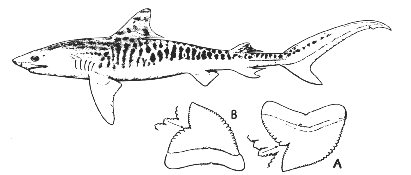Tiger shark Galeocerdo cuvier (LeSueur) 1822
LEOPARD SHARK
[Bigelow and Schroeder, 1948 p. 266.]
Description—
The tiger shark is characterized among the Atlantic members of its family by the forward position of its first dorsal fin (origin about over the arm pit of the pectorals), combined with a caudal peduncle with a low longitudinal ridge of skin on either side, besides a well-marked semilunar pit below as well as above; a very small second dorsal fin; a furrow, about as long as the snout along either side of the upper jaw; a very slender-tipped caudal fin with moderately large and pointed lower lobe; and large teeth alike in the two jaws, of very characteristic shape, with convex inner margins, deeply and conspicuously notched outer margins and strongly serrate edges (fig. 11).
Young tiger sharks are rather slender, but they become very heavy forward, with growth, though they continue tapering toward the tail. The first dorsal fin is high, triangular, and nearly as large as the pectorals, while the second dorsal is hardly one-third to one-fourth as high as the first and stands over the anal, which is of about equal size. The lower tail lobe is almost half as long as the upper, the rear margin of which is notched near the tip. The large size of the head, with very short, obtusely rounded front outline, and broad mouth occupying nearly four-fifths of the width of the head, with long grooves along the upper jaw, combined with the unique shape of its teeth, make the "tiger" easy to recognize among Gulf of Maine sharks.
Color—
Gray, or grayish brown, darkest on the upper surface. Young "tigers" up to 5 or 6 feet long, are more or less conspicuously spotted or barred with darker brown on the back and along the upper parts of the sides. But these markings fade with advancing age until large specimens are plain colored, or nearly so.
Size—
Tiger sharks are small at birth, corresponding to the large numbers in a litter, free living specimens having been reported only 18 to 19 inches long. By the time they mature they are among the larger sharks; but their size has often been overestimated. The majority of tigers caught in centers of abundance are less than 12 to 13 feet long, and the largest measured lately in the western Atlantic was one of about 18 feet, from Cuba. Repeated statements that the tiger grows to a maximum length of 30 feet have no reliable foundation, so far as we can discover.
A 4-foot specimen from Woods Hole weighed 25¾ pounds when taken from the water. Larger tigers vary widely in weight at given lengths depending on how fat they are and on the stage of development of the young in gravid females. Specimens from various localities have weighed 37 pounds at 5½ feet; 168 pounds at 6 feet; 366 to 718 pounds at 10 to 11 feet; 450 to 825 pounds at 11 to 12 feet; 630 to 1,324 pounds at 12 to 13 [page 38] feet; and 1,028 to 1,395 pounds at 13 to 14 feet.[86]
Habits—
This voracious shark, with wide jaws and powerful teeth, preys upon the large sea turtles, other sharks, fish, and occasionally on invertebrates such as horseshoe crabs, crabs, conchs, whelks. It is proverbial for its habit of feeding on slaughter-house wastes or any other carrion. Remnants of squeteague, mackerel, hake, scup, menhaden, goosefish, and dogfish all have been found in stomachs of tiger sharks taken at Woods Hole.[87] There is no placental connection between mother and young, and the broods are very large, as many as 82 having been counted in a large female; but other litters as small as 10 to 14. In the West Indies it is much dreaded, whether or not with good cause.
General range—
Cosmopolitan in the warmer waters of all oceans; straying northward as far as Cape Cod on the American coast of the Atlantic.
Occurrence in the Gulf of Maine—
A few tiger sharks are taken in fish traps in the Woods Hole region every year, seldom before August or later than October although one was caught there July 20, 1951.[88] These specimens usually have been about 5 feet long, at most about 8 feet, and very rarely does a full-grown tiger shark stray so far from its tropical home. The tiger has not yet been recorded (on reliable evidence) from within the limits of the Gulf of Maine. It is included here because of the likelihood that a stray specimen may occasionally round the elbow of Cape Cod, or be encountered on the offshore Banks.[89]
[86] For further details and references, see Bigelow and Schroeder, Fishes Western North Atlantic, Pt. 1, 1948, p. 269.
[87] Bell and Nichols (Copeia, No. 92, March 1921, pp. 17-20) list the stomach contents of a number of tiger sharks caught off Morehead City, N. C.
[88] This shark was 8 feet, 3 inches long, taken in a pound net off Quisset Harbor, Buzzards Bay.
[89] The statement in the first edition that a tiger shark was once taken at Provincetown was an error. The original description of the specimen in question (Atwood, Proc. Boston Soc. Nat. Hist., vol. 10, 1865, p. 81) suggests that it was a mako (Isurus oxyrinchus).
